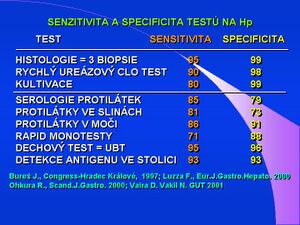Detection of antibodies against Helicobacter pylori
Antibodies against Helicobacter pylori in the serum can be detected by various immunological and serological techniques such as immunoblotting, immunofluorescence, hemagglutination, complement fixation, latex agglutination test and others. However the most common method is indisputably ELISA – it is a simple, fast, cheap and reliable technique. However, the specificity and sensitivity of the method is highly dependent on the antigen used – from the whole cells, through the ultrasound sonicate, glycine extract to protein purification. In 1989, HM-CAP, high molecular weight cell-associated protein, were isolated with a sensitivity and specificity of 95 %.
Serological detection of antibodies to Helicobacter pylori is of clinical importance especially for for long term observation after treatment and for monitoring the success of Helicobacter pylori eradication. The decrease of the IgG to < 50 % after 6 months of the treatment shows specificity of 95 % and sensitivity 97 %. Indications include screening patients who are at risk, such as kidney transplant patients , where helicobacter infection increases the risk of peptic ulcer and bleeding.
Antibodies against Helicobacter pylori can be also detected in saliva and urine samples by immunological methods. There are many rapid tests which detect antibodies against Helicobacter. For example, by performing capillary blood sampling of whole blood, and with the use of immunoaffinity chromatography, we get the result after a couple of minutes. Sensitivity and specificity of these tests are relatively low – 70-85 %.
The serological diagnosis of antibodies to Helicobacter pylori also includes the detection of cagA, vacA and iceA antigens, the presence of which specifies Helicobacter pylori strains with higher pathogenicity. These antigens are detected with help of classic ELISA tests on the microtiter plates or PCR techniques. Demonstration of Helicobacter pylori and its strains by PCR methods is in the phase of clinical testing, it is not used in routine diagnostics yet. The diagnostic significance of the determination of antibodies to Helicobacter pylori is still the subject of research, it is not suitable for screening programs.
Links[edit | edit source]
Related Articles [ modify | edit source ][edit | edit source]
References[edit | edit source]
- with permission of the author adapted from KOCNA, Petr. GastroLab : MiniEncyklopedie laboratorních metod v gastroenterologii [online]. ©2002. The last revision 2011-01-08, [cit. 2011-03-04]. <http://www1.lf1.cuni.cz/~kocna/glab/glency1.htm>.
Bibliography[edit | edit source]
- PENG, NJ. , et al. Comparison of noninvasive diagnostic tests for Helicobacter pylori infection. Medical Principles and Practice (International Journal of the Kuwait University Health Sciences Centre) [online]. 2009, vol. 18, no. 1, p. 57-61, Available from <https://www.ncbi.nlm.nih.gov/pubmed/19060493?ordinalpos=19&itool=EntrezSystem2.PEntrez.Pubmed.Pubmed_ResultsPanel.Pubmed_DefaultReportPanel.Pubmed_RVDocSum>. ISSN 1011-7571, eISSN 1423-0151. PMID: 19060493.
- JANULAITYTE-GÜNTHER, D. , et al. Combined serum IgG response to Helicobacter pylori VacA and CagA predicts gastric cancer. FEMS immunology and medical microbiology [online]. 2007, vol. 50, no. 2, p. 220-225, Available from <https://www.ncbi.nlm.nih.gov/sites/entrez?Db=pubmed&Cmd=ShowDetailView&TermToSearch=17567283&ordinalpos=31&itool=EntrezSystem2.PEntrez.Pubmed.Pubmed_ResultsPanel.Pubmed_RVDocSum>. ISSN 0928-8244, eISSN 1574-695X. PMID: 17567283.
- ZAMBON, CF. , et al. Non-invasive diagnosis of Helicobacter pylori infection: simplified 13C-urea breath test, stool antigen testing, or DNA PCR in human feces in a clinical laboratory setting?. Clinical biochemistry [online]. 2004, vol. 37, no. 4, p. 261-267, Available from <https://www.ncbi.nlm.nih.gov/pubmed/15003727?dopt=Abstract>. ISSN 0009-9120, eISSN 1873-2933. PMID: 15003727.
- CHEN, TS. , et al. Immunoglobulin G antibody against Helicobacter pylori: clinical implications of levels found in serum. Clinical and diagnostic laboratory immunology [online]. 2002, vol. 9, no. 5, p. 1044-1048, Available from <https://www.ncbi.nlm.nih.gov/pubmed/12204957?dopt=Abstract>. ISSN 1071-412X, eISSN 1098-6588. PMID: 12204957.
- KINDERMANN, A. , et al. Evaluation of a rapid whole blood test to detect Helicobacter pylori infection in children. Scandinavian journal of gastroenterology [online]. 2001, vol. 36, no. 6, p. 572-576, Available from <https://www.ncbi.nlm.nih.gov/pubmed/11424314?dopt=Abstract>. ISSN 0036-5521, eISSN 1502-7708. PMID: 11424314.
- ARENTS, NL. , et al. The importance of vacA, cagA, and iceA genotypes of Helicobacter pylori infection in peptic ulcer disease and gastroesophageal reflux disease. The American journal of gastroenterology [online]. 2002, vol. 97, no. 4, p. 1065, Available from <https://www.ncbi.nlm.nih.gov/pubmed/11569682?dopt=Abstract>. ISSN 0002-9270, eISSN 1572-0241. PMID: 11569682.

